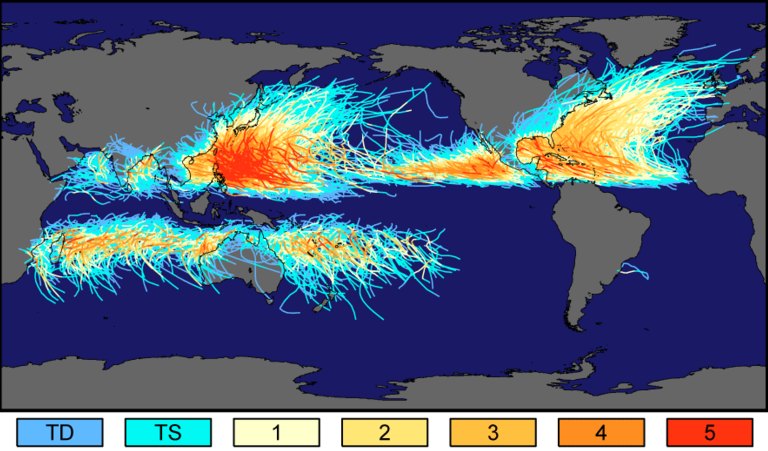Map by Reddit user Hockputer09
The swirling hurricane tracking map you’re looking at tells one of nature’s most fascinating stories.
Like colorful streamers painted across the globe’s oceans, these tracks represent nearly 150 years of tropical cyclone data, and they reveal a remarkable pattern that would make any physicist smile.
Notice something missing? Despite thousands upon thousands of storm tracks crisscrossing our planet’s waters, not a single hurricane has ever crossed the equator. This isn’t a coincidence, it’s physics in action.
The Invisible Force Field
The reason behind this phenomenon lies in something called the Coriolis effect, named after French mathematician Gustave-Gaspard Coriolis. This effect is due to Earth’s rotation, causing moving air to twist in a circular motion, but at the equator, the Coriolis effect is nearly zero.
Think of it this way: trying to form a hurricane at the equator is like trying to spin a top without twisting it. The background spin simply isn’t there to organize thunderstorms into the rotating powerhouses we call hurricanes.
Hurricanes cannot form within five degrees latitude of the equator, creating what meteorologists call the “doldrums,” a roughly 400-mile-wide strip on either side of the equatorial line where tropical cyclones can’t get their act together.
The Spinning Science
Here’s where it gets really interesting. In the Northern Hemisphere, the Coriolis effect creates counterclockwise spinning motion, while the opposite occurs in the Southern Hemisphere.
Since storms would have to perform the physically impossible feat of changing direction as they cross over from one hemisphere to another, they’re essentially trapped in their respective halves of the planet.
But what would happen if, hypothetically, a hurricane somehow made it across? As it moved into the opposite hemisphere, Coriolis would work against the storm, and it would spin down. The storm would become disorganized and cease to be a hurricane, probably becoming a remnant low.
By the Numbers
The data backing this up is impressive. Based on a 30-year climate period from 1991 to 2020, an average Atlantic hurricane season alone has 14 named storms, 7 hurricanes, and 3 major hurricanes.
The International Best Track Archive includes data for more than 6,000 global tropical cyclones spanning the last 150 years, and not one has crossed that invisible equatorial line.
The Bigger Picture
Understanding why hurricanes respect the equator gives us insight into the incredible complexity of our planet’s weather systems. It’s a reminder that even the most chaotic-seeming natural phenomena follow predictable physical laws. Scientists continue studying these patterns, especially as climate change may be causing shifts in tropical cyclone intensity and behavior, but the fundamental barrier remains unchanged.
So the next time you see a hurricane tracking map, take a moment to appreciate this invisible force field that has never been breached. It’s physics, geography, and meteorology all rolled into one beautiful, unbroken pattern that spans our entire planet.
Help us out by sharing this map:
